What size bike do I need? A comprehensive bike size guide
How to decode a geometry chart to find the right size bike for you

The most crucial factor when buying a bike is to make sure the frame fits. Just like how you might wear a size 10 shoe in Nike and a 10.5 in Adidas, there is no standardisation when it comes to bike frames, and sizing can vary drastically from brand to brand. Worse, trying to decode a geometry chart for some can be as hard as wrapping their heads around quantum physics.
While minor adjustments can be made with stem length and saddle setback, ultimately if a bike frame is too big or small, the amount of available adjustment won't be great enough, and it will influence the bike's handling characteristics as well as cause issues when it comes to comfort. This is especially true when riding one of the best road bikes because you will essentially maintain that same position for the duration of the ride, and if it’s wrong, you’re in for many hours of pain — the bad kind, that is.
What makes things even more complicated is that people are built differently; some people have short torsos and long legs, while others have a long torso and short legs. This means two people who are the same height might not fit on the same bike.
While we can’t offer a specific chart that will tell you exactly what size frame will be perfect for the dimensions of your body, what we can do is help to demystify the numbers on the geometry chart and show you how to use them to figure out the right size for you.
Luckily, the components on a bike do allow for a little bit of leeway. Saddles usually have around 7cm of fore-aft adjustability, stems can be swapped for shorter or longer versions with shallower or steeper angles that raise or lower the handlebars, and most of the best road handlebars can be bought in a choice of around five different widths. Cranks can be swapped for shorter or longer lengths, many seatposts are available in a couple of shapes that adjust their bend, known as 'layback', and some bikes even come with flip chips that adjust the geometry.
However, don't think that gives you a free ride when deciding which size bike you need. Just like how a house with poor foundations will fall, if your bike's foundation - the frame - is incorrect, you're setting yourself up for a bad time.
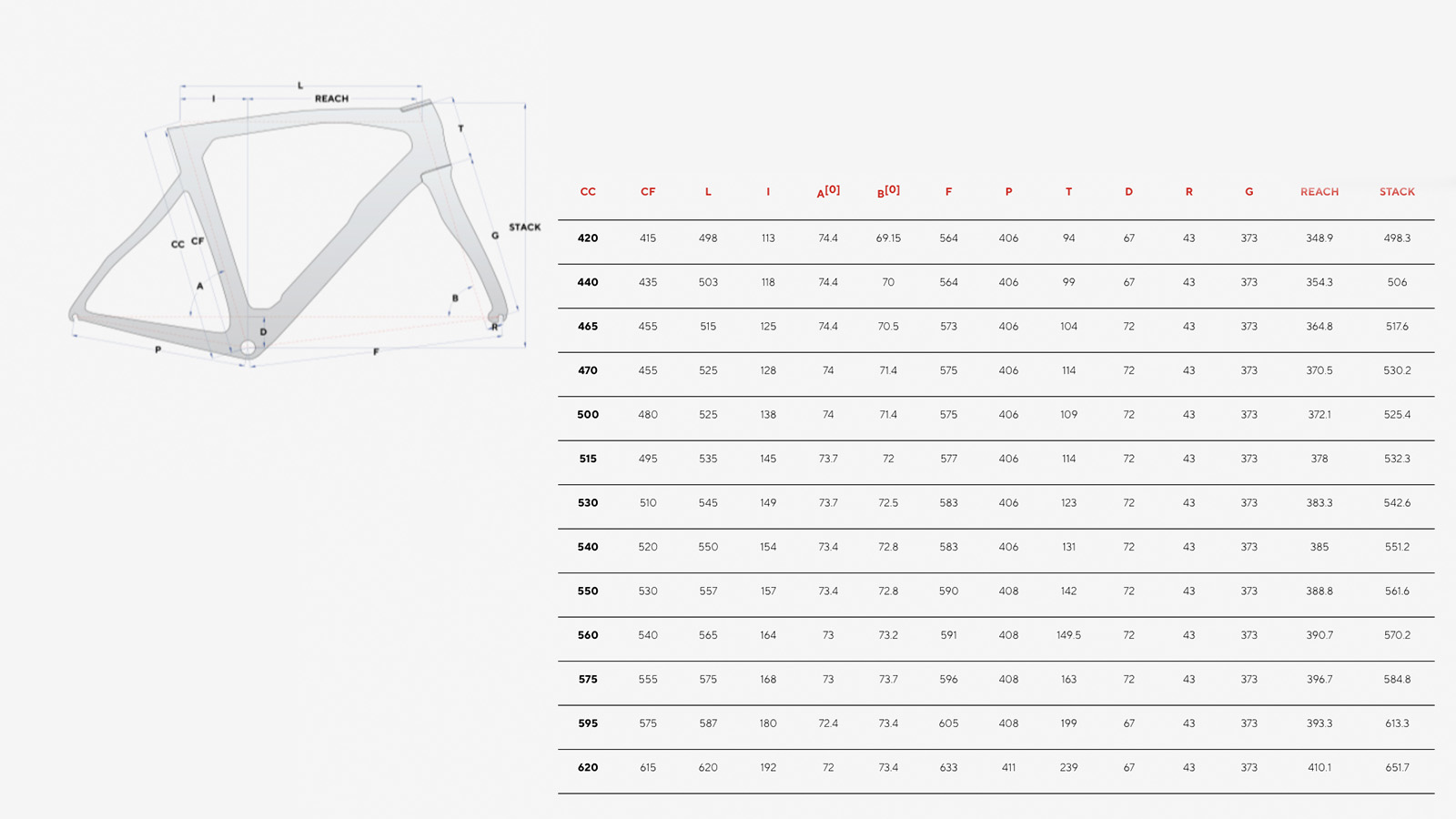
Bike geometry
A geometry chart comprises measurements of almost everything to do with the frame. Some of these numbers are extremely helpful in gauging whether a frame will fit your body or not, while others can be ignored entirely. Here's a rundown of the important numbers, and what they mean.
Top tube length and effective top tube length
When we request bikes in for review, the first figure we look at is the top tube length or, more often, the effective top tube length. This is the length from the head tube to the seat tube and is the measurement most brands base their sizing around.
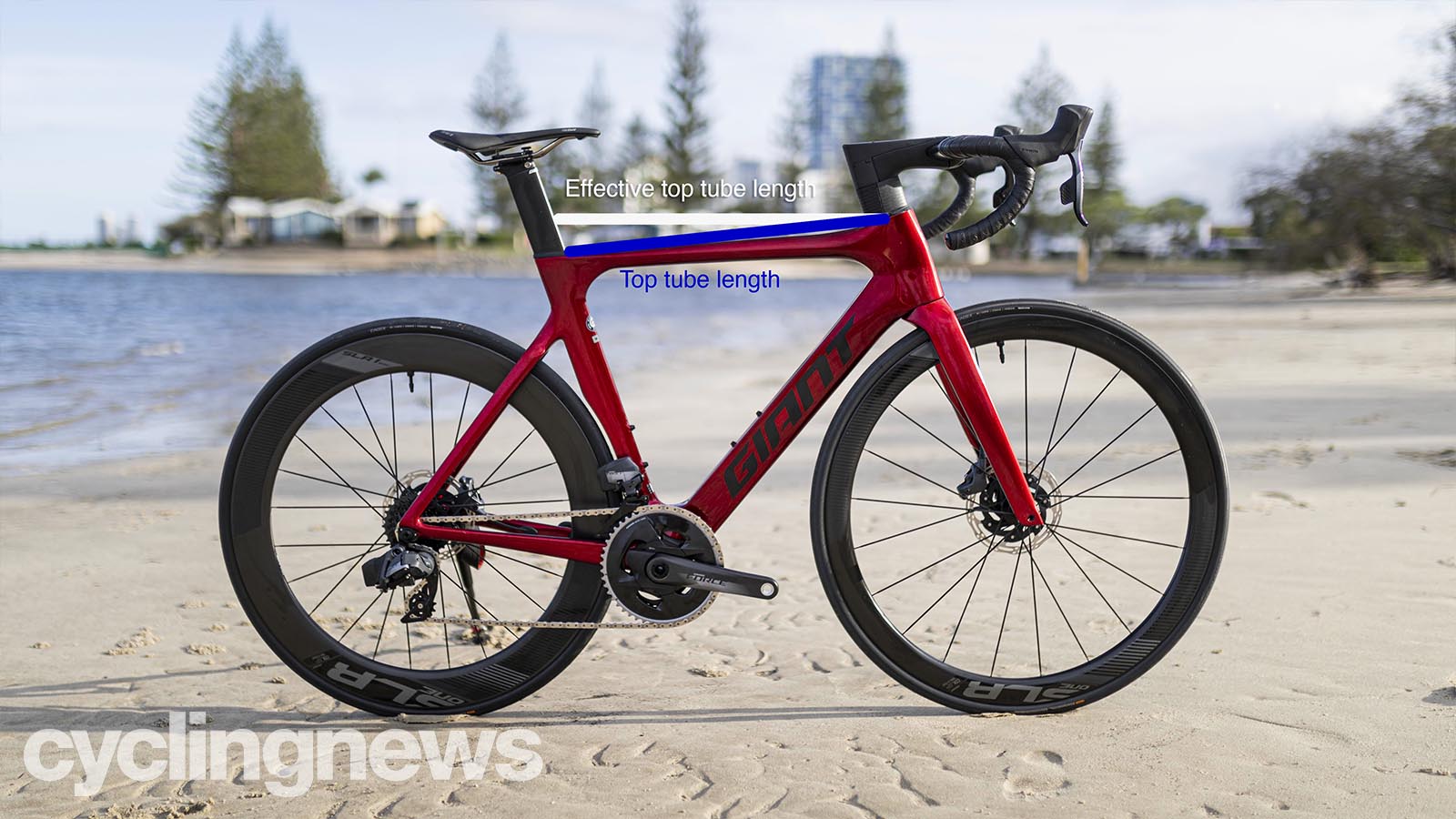
The top tube and effective top tube length can differ because of the modern compact or semi-compact geometry bikes. Old school road bikes see a completely horizontal top tube, while the top tube on most modern bikes slopes downward. This can increase the length of the physical section of tubing but does not increase the actual distance between the head- and seat tubes.
The top tube relates directly to your arm and torso length, and it is a figure that doesn’t leave a ton of leeway to be fixed. If you have a bike with a top tube that is too short or too long, small deficits can be remedied with a new stem of different length. Realistically there is about 20mm of leeway shorter or longer than a stock road bike stem, any longer or shorter, and you will drastically change the handling characteristics of your bike.
Reach
Reach is a slightly more difficult measurement to get your head around and refers to the horizontal distance from your bottom bracket to the top of the head tube.
If you were to draw a line from the centre of the bottom bracket straight up through the frame and one from the centre of the head tube back; 'reach' is the horizontal distance between the head tube and the vertical line.
Reach is the key measurement for mountain bikes as the majority of your time on the bike will be in a standing position, with your saddle well behind your body, making the length from the head tube to the seat tube somewhat irrelevant — because you’re not actually sitting on the seat.
For road riders, reach tells us exactly how far you have to ‘reach’ to grab the handlebars and is not subject to wonky measuring and sizing practices between brands. Because of this, it is one of the two key figures to determine how one bike compares to another.
For example, a Trek Emonda has a reach of 386mm in a size 54cm frame, a Specialized Tarmac SL7 has a reach of 387mm also in a size 54cm, and a Scott Addict RC has a reach of 389mm in size 54cm. While the difference is only a few millimetres, each one of these race bikes, which are supposed to be the same size, are actually a little bit different.
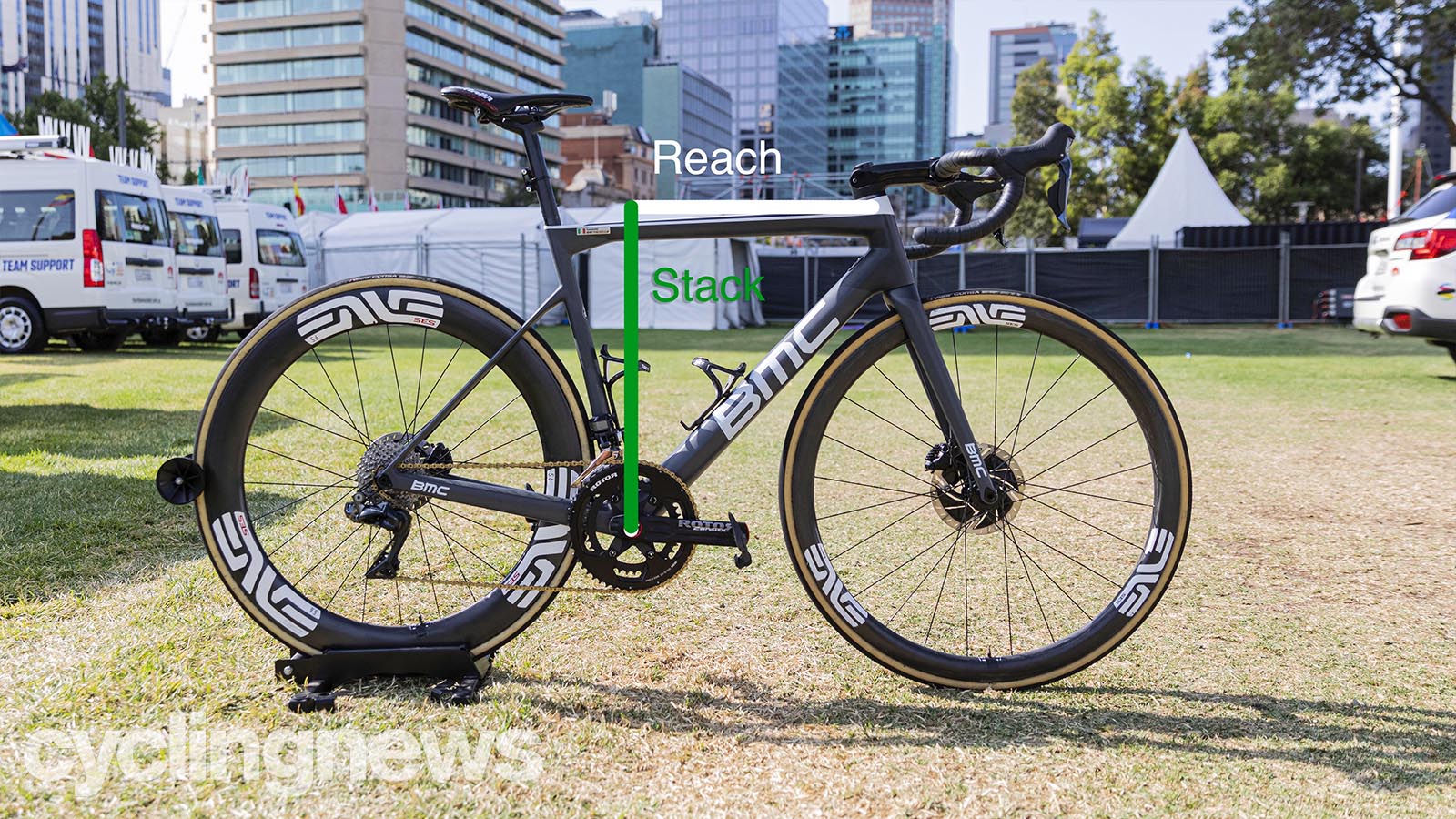
Stack
Stack is the other key sizing figure which denotes the vertical distance between the bottom bracket and the centre of the head headtube — measured using the same imaginary line that we drew straight up out of the bottom bracket when we measured reach.
The frame stack height measurement tells us how upright or aggressive a rider's position will be on the bike. Racers tend to prefer a shorter stack because it allows them to get their handlebars low to remain lower, more aerodynamic, and shift more weight over the front wheel for cornering. Endurance and beginner riders are usually better suited to taller stacks because it allows for a more upright, comfortable position.
Small adjustments to the overall stack height can, of course, be made by using angled stems and spacers, but again, this is not unlimited.
For example, Cannondale’s endurance bike, the Synapse, has a frame stack of 570mm in size 54, while the SuperSix Evo race bike measures 554mm in the same size.
Other important measurements
When choosing the right size for you, the measurements above will be the go-to numbers, however, if you find yourself between sizes, or you want to choose between two similar-sized bikes from different manufacturers, the following measurements can help when it comes into the nuanced differences that will affect the ride feel, stability, handling and more.
Seat tube length and standover height
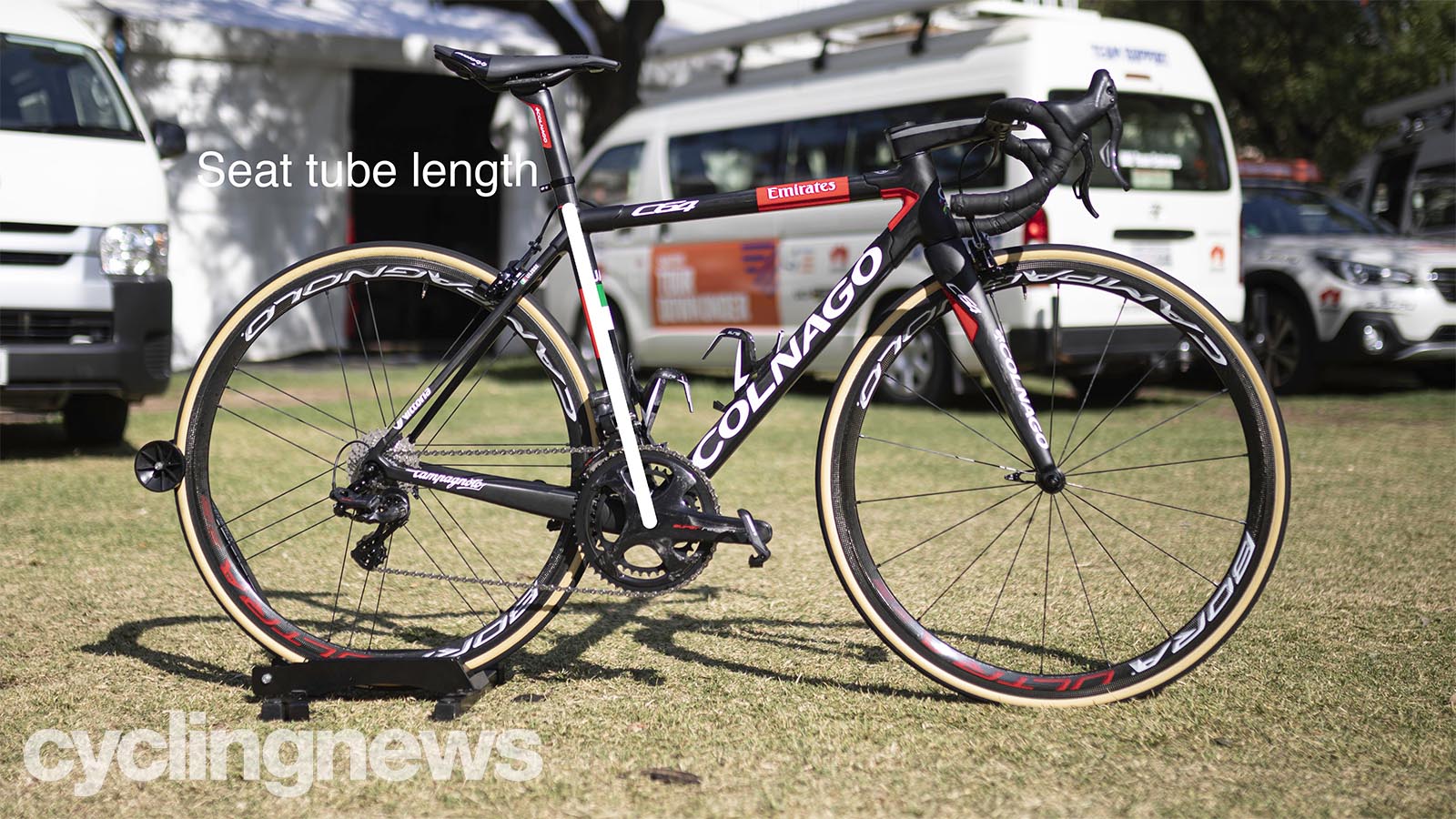
Seat tube length is one of the more simple measurements on a bike and is the distance between the centre of the bottom bracket to the top of the seat tube (excluding the seatpost, which is adjustable, of course).
In the olden days, bikes were sized based on their seat tube length because it was usually the same as the top tube length; this was before the introduction of sloping top tubes and compact frame geometries. While a select few brands, like De Rosa, still size their bikes based on seat tube length, most use the top tube length, if they haven’t opted for t-shirt style small/medium/large sizing.
Seat tube length is still relevant, however, as it provides an insight into a bike's standover height. Too high a standover height, and your bike may leave you with a bruised undercarriage when you stop and climb off. There really isn’t such a thing as too low a standover height; modern mountain bikes are the perfect example of this. That said, as seat tube length and standover height are proportional to the rest of a bike’s geometry, it may signify the need for a bigger frame.
Head tube angle
The head tube angle of a bike doesn’t actually tell us anything about the size of a bike, but instead provides an insight into its handling characteristics; although as with everything else, it's not the only determining factor. Fork rake, trail, stem length, handlebar width, chainstay length, and even BB height and drop all affect how a bike handles.
A steeper head angle will be a higher number, offering sharper, more responsive handling, and delicate inputs can illicit mid-corner line changes. With the handling being so light, bikes with steep head angles can sometimes feel nervous at high speed. A slacker head angle (lower number), on the other hand, will be more stable, especially at speed, but will require a bit more gusto to change your line.
Race bikes generally see head tube angle between 72.5 and 73 degrees, endurance bikes are often between 70 and 72 degrees, and cyclocross bikes usually range from 70 to 71 degrees — of course, there are outliers in every category.
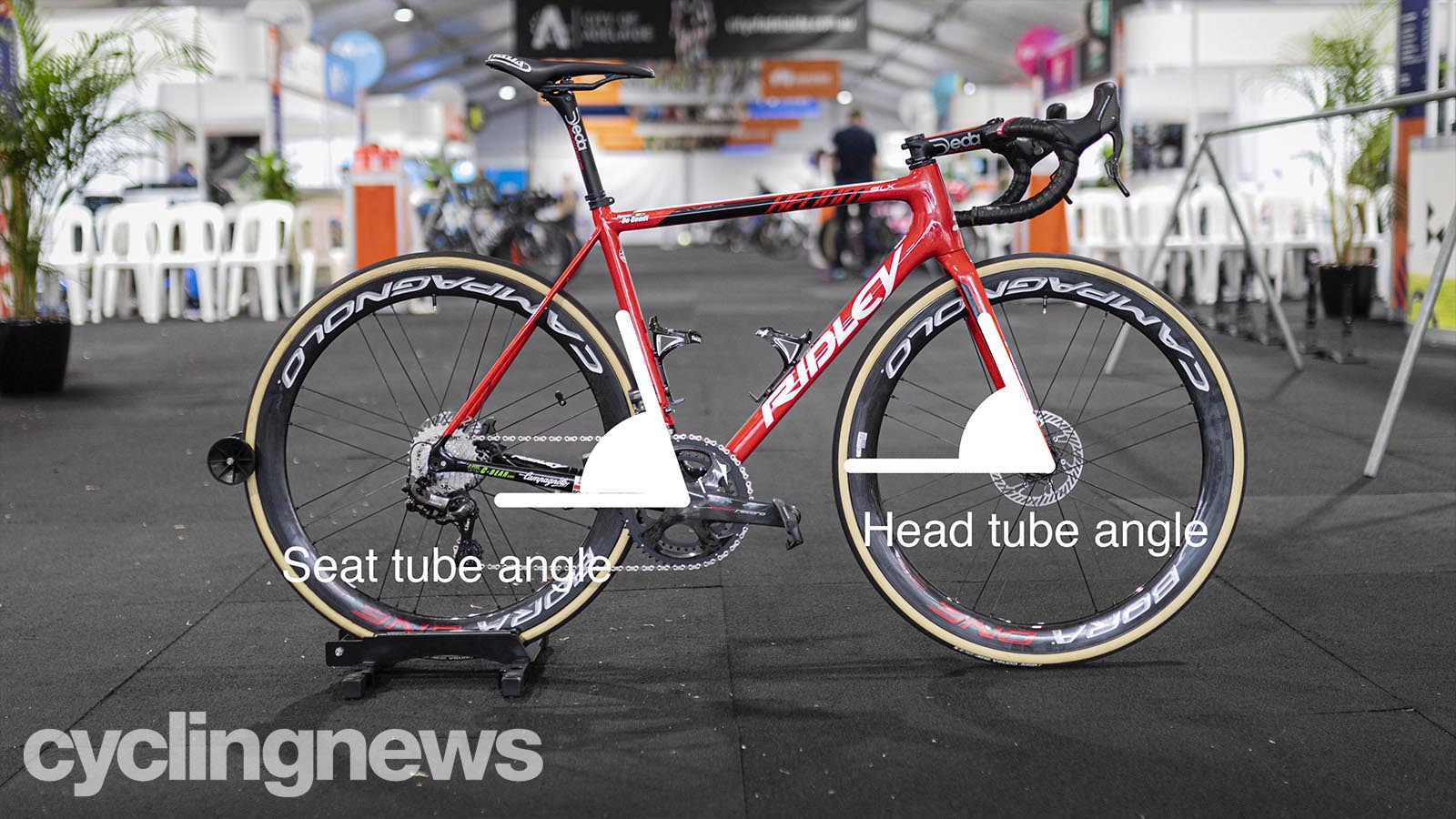
Seat tube angle
The seat tube angle is, you guessed it, the angle of the top of the seat tube, relative to the centre of the bottom bracket.
Usually, on smaller bikes, the seat tube angle will be a bit steeper as riders with shorter legs need to be closer to the BB than riders with longer legs.
On mountain bikes, seat tube angles have increased dramatically as the geometries have become more progressive to help riders maintain traction on steep and technical climbs. On the other hand, road bikes have remained relatively stable, clocking in around 74-degrees, give or take a few degrees depending on the size and style of bike.
While the seat angle of a frame is set, adjustments can be made via a setback seat post or the fore and aft on the saddle rails. The position you’re shooting for is to have your knee directly above your pedal axle with the crank when your foot is at the three o’clock position.
Bike geometry comparison
One problem we face when buying a bike is that each brand lays out its geometry charts in a different way, and this makes comparing two bikes from two separate brands difficult. Expand that to five bikes from five brands and you can get lost in the numbers in no time.
Thankfully, we clearly weren't alone in finding it a headache, as a few clever people have built tools that simplify bike geometry comparison.
Our go-to choice is Geometry Geeks, where you can simply search for the bikes you wish to select, hit compare, and it will bring up a standardised table that allows you to easily see the differences between your chosen frames. Others such as Bike Insights and Velogic Fit provide a similar solution.
So what does this all mean?
We have thrown quite a lot of general information at you here, and hopefully, you’re better equipped to decode the geometry chart of that new bike you’ve been lusting over.
But how do you take this information and figure out what size bike is right for you? Below is a basic size chart based on rider height to get you within the ballpark.
| How tall are you? | Header Cell - Column 1 | Bike size |
|---|---|---|
| Centemetres | Feet and inches | Effective top tube length |
| 148 to 152cm | 4ft 10in to 5ft 2in | 47 to 48cm |
| 152 to 160cm | 5ft 0in to 5ft 3in | 49 to 50cm |
| 160 to168 | 5ft 3in to 5ft 6in | 51 to 53cm |
| 168 to 175 | 5ft 3in to 5ft 9in | 54 to 55cm |
| 175 to 183 | 5ft 9in to 6ft 0in | 56 to 58cm |
| 183 to191 | 6ft 0in to 6ft 3in | 58 to 60cm |
| 191 and up | 6ft 3in and up | 61cm to 63cm |
Bike size guides
Remember, that table is only providing a rough ballpark. To get a better idea of what size bike you need to choose, you should consult the size guides provided by the brand you're looking to buy. Online retailers like Competitive Cyclist, Jenson USA, and Bicycles Online also have pretty good sizing calculators that provide you with a decent starting point. However, even armed with this information, you should still only use it as a guide. The geometry charts are the true determiner of whether or not a bike will fit, and if so, how it will fit.
You will notice that we have only included effective top tube length in the sizing chart above, and have not included the t-shirt style sizing employed by some brands. This is because even among those that use small/medium/large to size their bikes, there is no standardisation. For example, a size M Giant TCR Advanced SL 0 Disc has an effective top tube length of 555mm while size M Ridley Helium SLX disc has a top tube length of 565mm — the size small has an effective top tube of 545mm. If you look at our basic size chart above, these fall into two different height categories. So if you are 5ft 9in tall, like this writer, you would ride a size M Giant and a size S Ridley.
The best way to find out if a bike fits is to go down to your local bike shop to try a few out and see what feels right. If possible, go and get a professional bike fit before you pull the trigger, or at the very least, get your local bike shop to help you choose the right size.
If you want to maximise your comfort and efficiency, our bike fit guide explains all the areas that can be adjusted to improve your comfort. Alternatively, a professional bike fit on your own bike will help you to dial everything from your saddle height to how many spacers you need down to the millimetre.
Now you've got the tools at your disposal, check out our guide to the best road bikes and pick the right bike for you.
Get The Leadout Newsletter
The latest race content, interviews, features, reviews and expert buying guides, direct to your inbox!
Based on the Gold Coast of Australia, Colin has written tech content for cycling publication for a decade. With hundreds of buyer's guides, reviews and how-tos published in Bike Radar, Cyclingnews, Bike Perfect and Cycling Weekly, as well as in numerous publications dedicated to his other passion, skiing.
Colin was a key contributor to Cyclingnews between 2019 and 2021, during which time he helped build the site's tech coverage from the ground up. Nowadays he works full-time as the news and content editor of Flow MTB magazine.